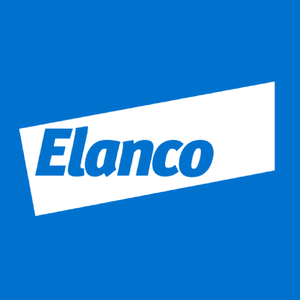
Viatris (VTRS)
We wouldn’t recommend Viatris. Not only has its sales growth been weak but also its negative returns on capital show it destroyed value.― StockStory Analyst Team
1. News
2. Summary
Why We Think Viatris Will Underperform
Created through the 2020 merger of Mylan and Pfizer's Upjohn division, Viatris (NASDAQ:VTRS) is a healthcare company that develops, manufactures, and distributes branded and generic medicines across more than 165 countries worldwide.
- Performance over the past five years shows its incremental sales were much less profitable, as its earnings per share fell by 13.1% annually
- Negative returns on capital show management lost money while trying to expand the business, and its decreasing returns suggest its historical profit centers are aging
- Annual sales declines of 4.4% for the past two years show its products and services struggled to connect with the market during this cycle


Viatris doesn’t fulfill our quality requirements. We’d search for superior opportunities elsewhere.
Why There Are Better Opportunities Than Viatris
High Quality
Investable
Underperform
Why There Are Better Opportunities Than Viatris
Viatris is trading at $10.68 per share, or 4.5x forward P/E. This certainly seems like a cheap stock, but we think there are valid reasons why it trades this way.
Our advice is to pay up for elite businesses whose advantages are tailwinds to earnings growth. Don’t get sucked into lower-quality businesses just because they seem like bargains. These mediocre businesses often never achieve a higher multiple as hoped, a phenomenon known as a “value trap”.
3. Viatris (VTRS) Research Report: Q3 CY2025 Update
Medication company Viatris (NASDAQ:VTRS) announced better-than-expected revenue in Q3 CY2025, but sales were flat year on year at $3.76 billion. The company’s full-year revenue guidance of $14.1 billion at the midpoint came in 1.2% above analysts’ estimates. Its non-GAAP profit of $0.67 per share was 8.5% above analysts’ consensus estimates.
Viatris (VTRS) Q3 CY2025 Highlights:
- Revenue: $3.76 billion vs analyst estimates of $3.61 billion (flat year on year, 4.3% beat)
- Adjusted EPS: $0.67 vs analyst estimates of $0.62 (8.5% beat)
- Adjusted EBITDA: $1.15 billion vs analyst estimates of $1.08 billion (30.7% margin, 6.7% beat)
- The company lifted its revenue guidance for the full year to $14.1 billion at the midpoint from $13.75 billion, a 2.5% increase
- Management raised its full-year Adjusted EPS guidance to $2.30 at the midpoint, a 3.1% increase
- EBITDA guidance for the full year is $4.1 billion at the midpoint, in line with analyst expectations
- Operating Margin: 4.8%, down from 6% in the same quarter last year
- Free Cash Flow Margin: 17.5%, down from 20% in the same quarter last year
- Market Capitalization: $12.53 billion
Company Overview
Created through the 2020 merger of Mylan and Pfizer's Upjohn division, Viatris (NASDAQ:VTRS) is a healthcare company that develops, manufactures, and distributes branded and generic medicines across more than 165 countries worldwide.
Viatris operates at the intersection of traditional pharmaceuticals and healthcare access, with a portfolio of over 1,400 approved molecules spanning major therapeutic areas including cardiovascular, infectious diseases, oncology, and central nervous system disorders. The company's offerings range from well-known branded medications to complex generics and over-the-counter products.
The company serves diverse customers including retail pharmacies, wholesalers, hospitals, and government health programs. When a hospital needs to stock its pharmacy with reliable medications, or when a retail pharmacy chain requires consistent supply of common prescriptions, Viatris provides these essential medicines through its global distribution network.
Viatris generates revenue through multiple channels. In substitution markets like France and Australia, pharmacists can substitute Viatris' products for prescribed brands. In tender markets such as Sweden and Germany, the company competes for government contracts to be the exclusive supplier of certain medications. In distribution markets like the U.S., Viatris sells directly to major wholesalers and pharmacy chains.
The company operates approximately 40 manufacturing facilities worldwide producing various dosage forms from oral tablets to injectables and complex delivery systems. Its global research and development platform focuses on both extending existing product lifecycles and developing new complex generics and biosimilars.
Through its "Global Healthcare Gateway," Viatris partners with other pharmaceutical companies to expand access to their products using Viatris' established regulatory expertise and distribution channels. This allows smaller innovators to reach global markets they couldn't access independently.
The company has structured its operations into four geographic segments: Developed Markets (North America and Europe), Greater China, JANZ (Japan, Australia, and New Zealand), and Emerging Markets covering over 125 developing countries.
4. Generic Pharmaceuticals
The generic pharmaceutical industry operates on a volume-driven, low-cost business model, producing bioequivalent versions of branded drugs once their patents expire. These companies benefit from consistent demand for affordable medications, as they are critical to reducing healthcare costs. Generics typically face lower R&D expenses and shorter regulatory approval timelines compared to branded drug makers, enabling cost efficiencies. However, the industry is highly competitive, with intense pricing pressures, thin margins, and frequent legal challenges from branded pharmaceutical companies over patent disputes. Looking ahead, the industry is supported by tailwinds such as the role of AI in streamlining drug development (reverse engineering complex formulations) and manufacturing efficiency (optimize processes and remove inefficiencies). Governments and insurers' focus on reducing drug costs can also boost generics' adoption. However, headwinds include escalating pricing pressure from large buyers like pharmacy chains and healthcare distributors as well as evolving regulatory hurdles.
Viatris competes with major pharmaceutical companies including Teva Pharmaceutical Industries (NYSE:TEVA), Novartis' Sandoz division (NYSE:NVS), Pfizer (NYSE:PFE), and Sun Pharmaceutical Industries (NSE:SUNPHARMA) in the global generic and branded generic medication markets.
5. Economies of Scale
Larger companies benefit from economies of scale, where fixed costs like infrastructure, technology, and administration are spread over a higher volume of goods or services, reducing the cost per unit. Scale can also lead to bargaining power with suppliers, greater brand recognition, and more investment firepower. A virtuous cycle can ensue if a scaled company plays its cards right.
With $14.12 billion in revenue over the past 12 months, Viatris has decent scale. This is important as it gives the company more leverage in a heavily regulated, competitive environment that is complex and resource-intensive.
6. Revenue Growth
Reviewing a company’s long-term sales performance reveals insights into its quality. Any business can have short-term success, but a top-tier one grows for years. Over the last five years, Viatris grew its sales at a mediocre 4.2% compounded annual growth rate. This fell short of our benchmark for the healthcare sector and is a tough starting point for our analysis.
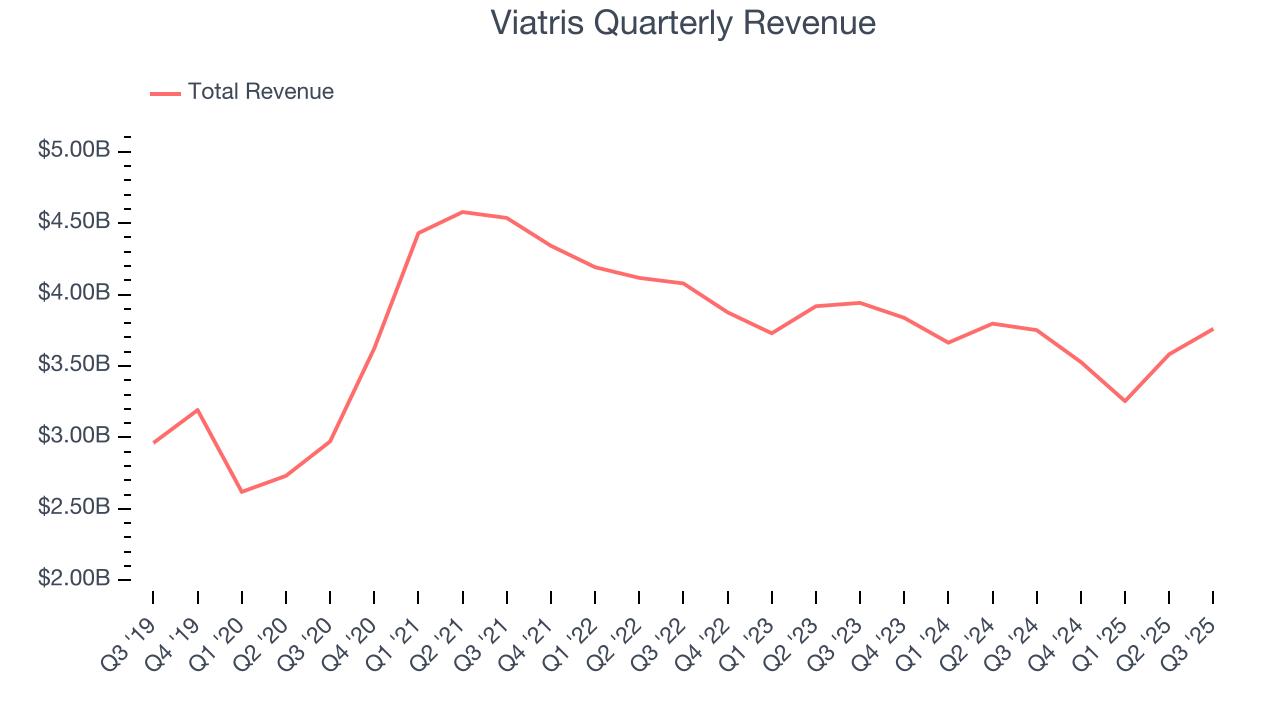
Long-term growth is the most important, but within healthcare, a half-decade historical view may miss new innovations or demand cycles. Viatris’s performance shows it grew in the past but relinquished its gains over the last two years, as its revenue fell by 4.4% annually. 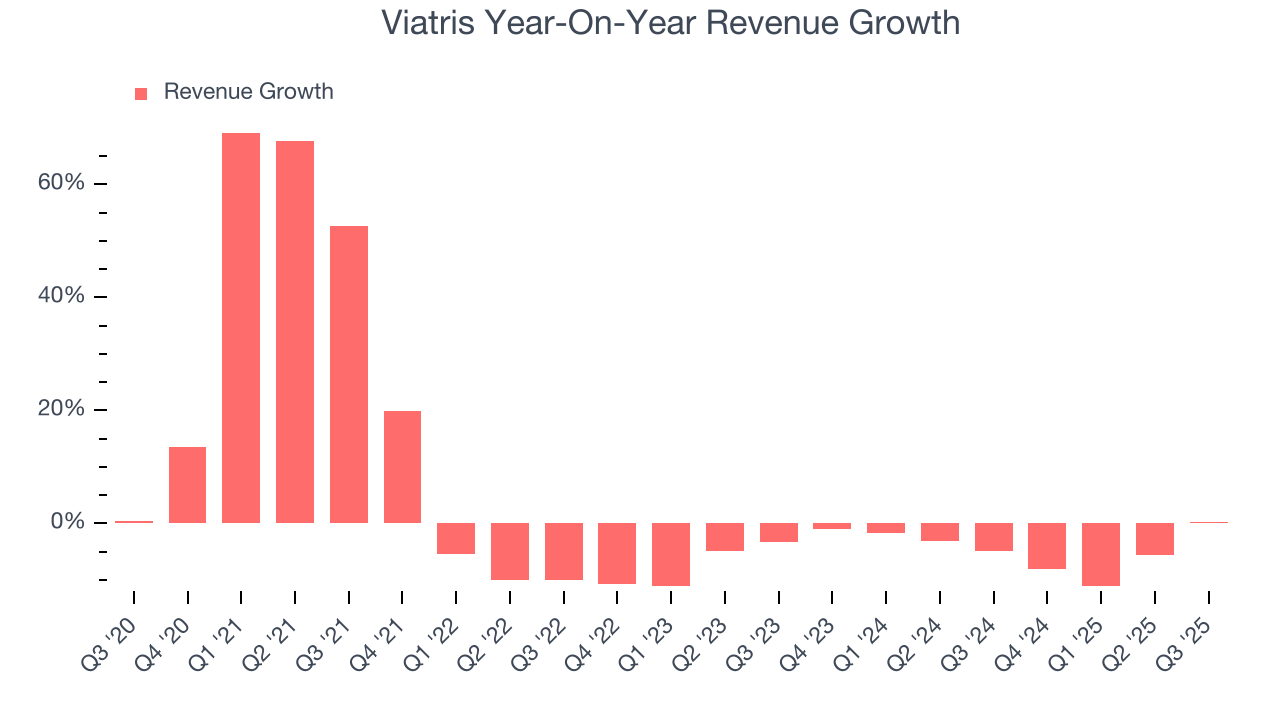
This quarter, Viatris’s $3.76 billion of revenue was flat year on year but beat Wall Street’s estimates by 4.3%.
Looking ahead, sell-side analysts expect revenue to remain flat over the next 12 months. While this projection implies its newer products and services will spur better top-line performance, it is still below average for the sector.
7. Operating Margin
Operating margin is an important measure of profitability as it shows the portion of revenue left after accounting for all core expenses – everything from the cost of goods sold to advertising and wages. It’s also useful for comparing profitability across companies with different levels of debt and tax rates because it excludes interest and taxes.
Although Viatris was profitable this quarter from an operational perspective, it’s generally struggled over a longer time period. Its expensive cost structure has contributed to an average operating margin of negative 1.3% over the last five years. Unprofitable healthcare companies require extra attention because they could get caught swimming naked when the tide goes out. It’s hard to trust that the business can endure a full cycle.
Looking at the trend in its profitability, Viatris’s operating margin decreased by 13.9 percentage points over the last five years. This performance was caused by more recent speed bumps as the company’s margin fell by 25.4 percentage points on a two-year basis. We’re disappointed in these results because it shows its expenses were rising and it couldn’t pass those costs onto its customers.
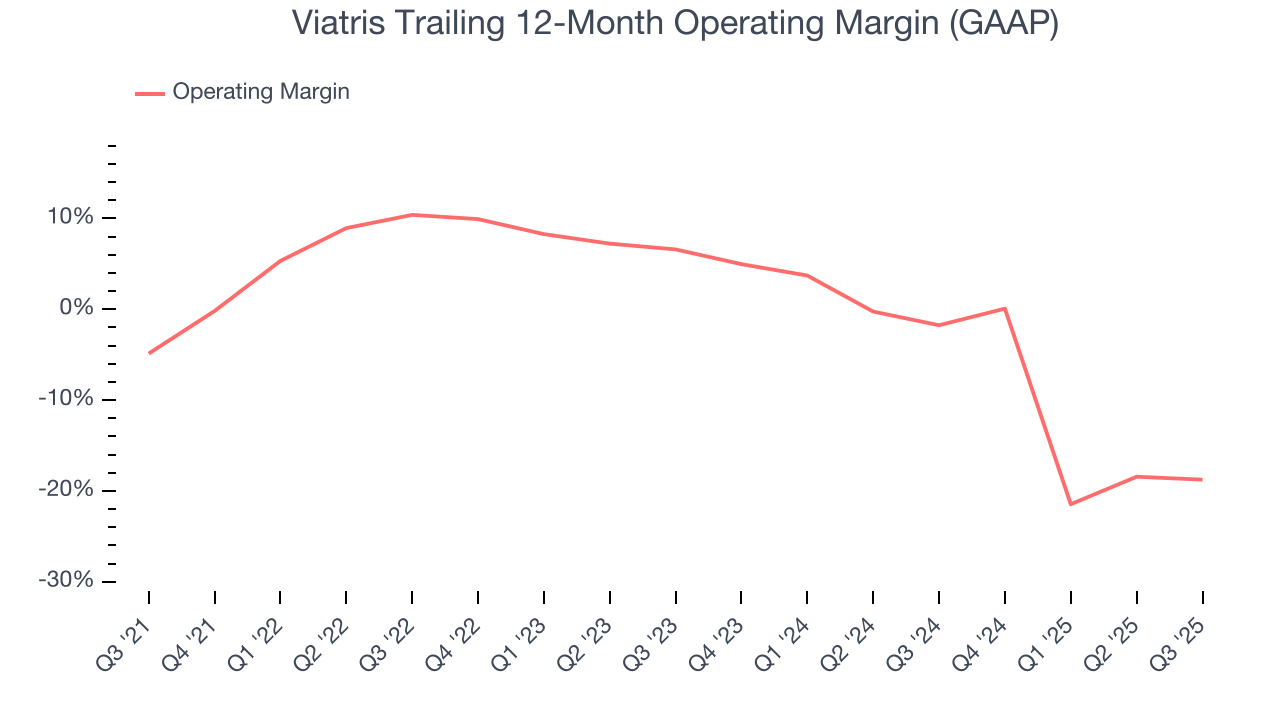
This quarter, Viatris generated an operating margin profit margin of 4.8%, down 1.3 percentage points year on year. This reduction is quite minuscule and indicates the company’s overall cost structure has been relatively stable.
8. Earnings Per Share
Revenue trends explain a company’s historical growth, but the long-term change in earnings per share (EPS) points to the profitability of that growth – for example, a company could inflate its sales through excessive spending on advertising and promotions.
Sadly for Viatris, its EPS declined by 13.1% annually over the last five years while its revenue grew by 4.2%. This tells us the company became less profitable on a per-share basis as it expanded.
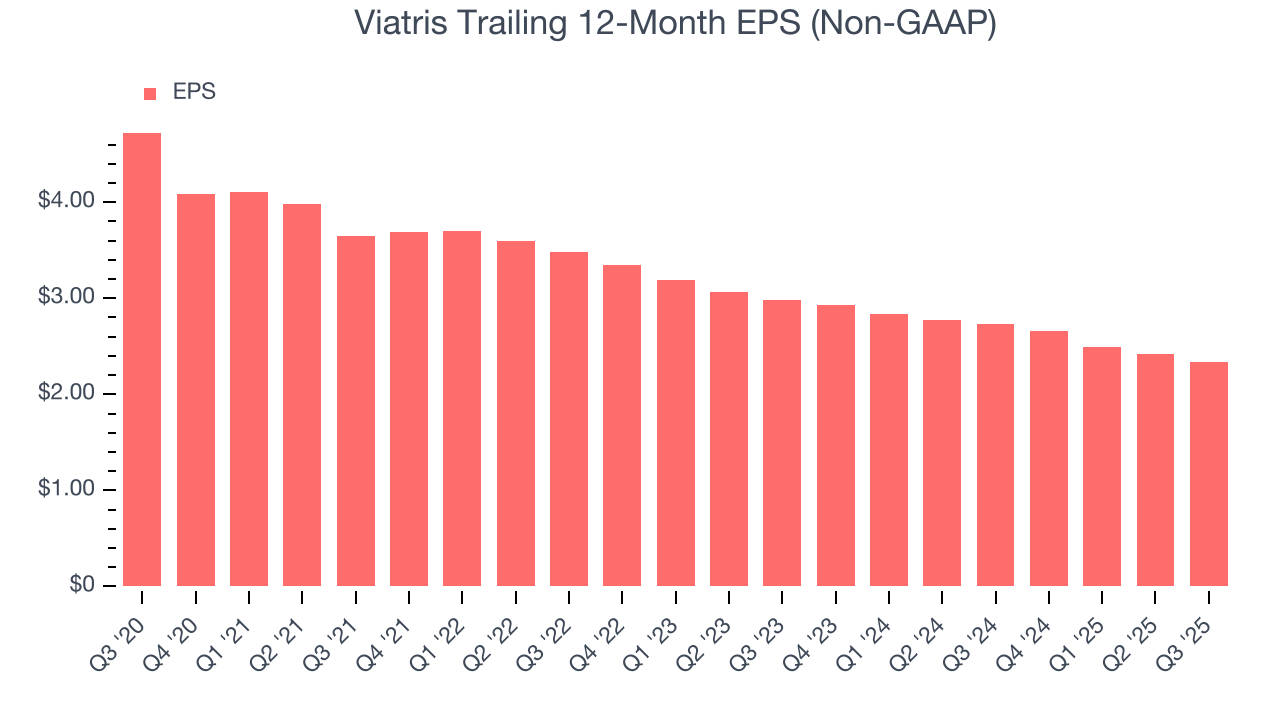
Diving into the nuances of Viatris’s earnings can give us a better understanding of its performance. As we mentioned earlier, Viatris’s operating margin declined by 13.9 percentage points over the last five years. Its share count also grew by 125%, meaning the company not only became less efficient with its operating expenses but also diluted its shareholders. 
In Q3, Viatris reported adjusted EPS of $0.67, down from $0.75 in the same quarter last year. Despite falling year on year, this print beat analysts’ estimates by 8.5%. Over the next 12 months, Wall Street expects Viatris’s full-year EPS of $2.34 to stay about the same.
9. Cash Is King
Free cash flow isn't a prominently featured metric in company financials and earnings releases, but we think it's telling because it accounts for all operating and capital expenses, making it tough to manipulate. Cash is king.
Viatris has shown impressive cash profitability, giving it the option to reinvest or return capital to investors. The company’s free cash flow margin averaged 13.9% over the last five years, better than the broader healthcare sector. The divergence from its underwhelming operating margin stems from the add-back of non-cash charges like depreciation and stock-based compensation. GAAP operating profit expenses these line items, but free cash flow does not.
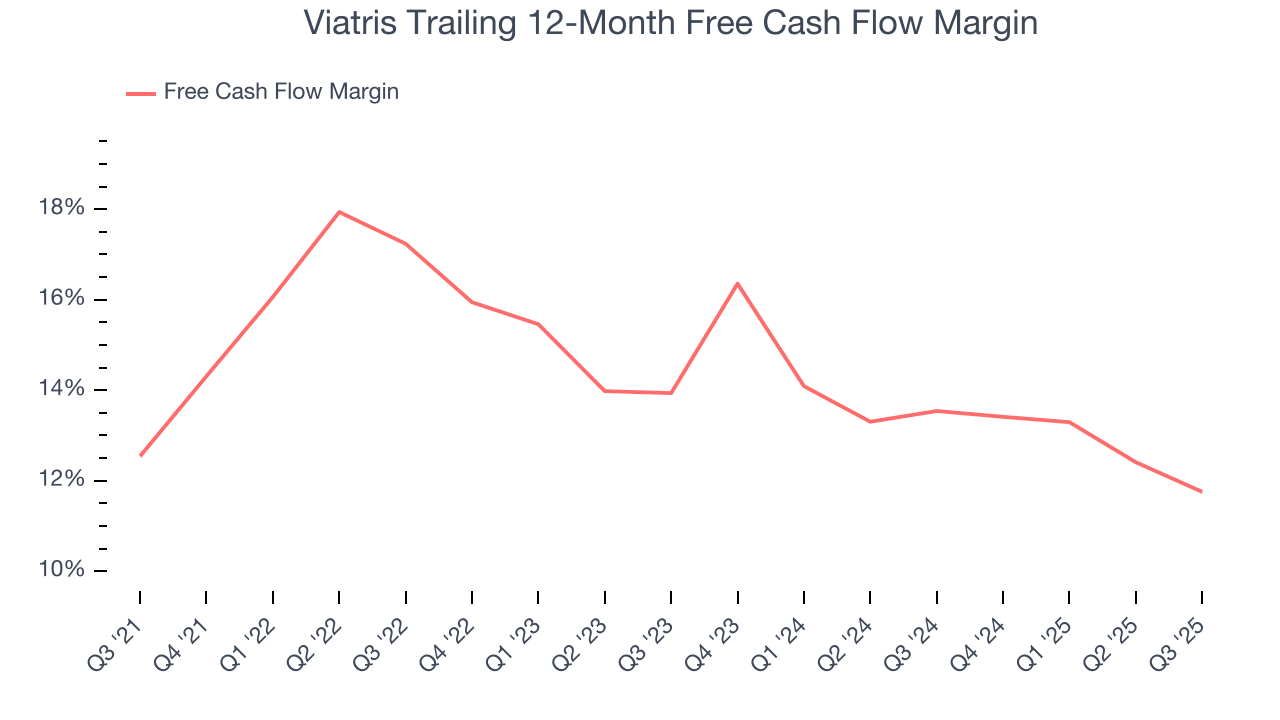
Viatris’s free cash flow clocked in at $658.1 million in Q3, equivalent to a 17.5% margin. The company’s cash profitability regressed as it was 2.5 percentage points lower than in the same quarter last year, but it’s still above its five-year average. We wouldn’t read too much into this quarter’s decline because investment needs can be seasonal, leading to short-term swings. Long-term trends are more important.
10. Return on Invested Capital (ROIC)
EPS and free cash flow tell us whether a company was profitable while growing its revenue. But was it capital-efficient? Enter ROIC, a metric showing how much operating profit a company generates relative to the money it has raised (debt and equity).
Viatris’s five-year average ROIC was negative 2.8%, meaning management lost money while trying to expand the business. Its returns were among the worst in the healthcare sector.

We like to invest in businesses with high returns, but the trend in a company’s ROIC is what often surprises the market and moves the stock price. Unfortunately, Viatris’s ROIC has decreased over the last few years. Paired with its already low returns, these declines suggest its profitable growth opportunities are few and far between.
11. Balance Sheet Assessment
Viatris reported $975.3 million of cash and $14.44 billion of debt on its balance sheet in the most recent quarter. As investors in high-quality companies, we primarily focus on two things: 1) that a company’s debt level isn’t too high and 2) that its interest payments are not excessively burdening the business.

With $4.14 billion of EBITDA over the last 12 months, we view Viatris’s 3.3× net-debt-to-EBITDA ratio as safe. We also see its $288.6 million of annual interest expenses as appropriate. The company’s profits give it plenty of breathing room, allowing it to continue investing in growth initiatives.
12. Key Takeaways from Viatris’s Q3 Results
We enjoyed seeing Viatris beat analysts’ revenue expectations this quarter. We were also glad its full-year revenue guidance slightly exceeded Wall Street’s estimates. Overall, we think this was a solid quarter with some key areas of upside. The market seemed to be hoping for more, and the stock traded down 4.6% to $10.30 immediately following the results.
13. Is Now The Time To Buy Viatris?
Updated: December 3, 2025 at 10:56 PM EST
The latest quarterly earnings matters, sure, but we actually think longer-term fundamentals and valuation matter more. Investors should consider all these pieces before deciding whether or not to invest in Viatris.
We see the value of companies making people healthier, but in the case of Viatris, we’re out. For starters, its revenue growth was mediocre over the last five years, and analysts expect its demand to deteriorate over the next 12 months. And while its impressive operating margins show it has a highly efficient business model, the downside is its declining EPS over the last five years makes it a less attractive asset to the public markets. On top of that, its relatively low ROIC suggests management has struggled to find compelling investment opportunities.
Viatris’s P/E ratio based on the next 12 months is 4.5x. While this valuation is optically cheap, the potential downside is huge given its shaky fundamentals. There are better stocks to buy right now.
Wall Street analysts have a consensus one-year price target of $12.13 on the company (compared to the current share price of $10.68).






